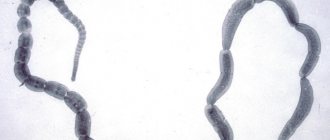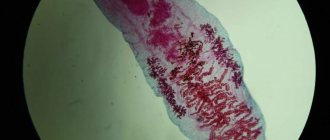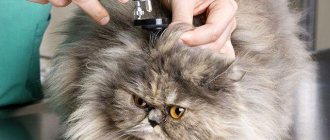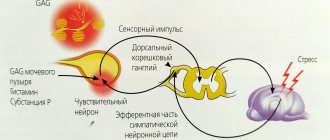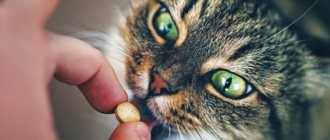Cucumber tapeworm in cats is the cause of dipylidiasis, a disease caused by the presence of tapeworms in the digestive tract. The helminth belongs to the cystode class of parasites and owes its original name to the shape of its segments, reminiscent of sprouted cucumber seeds. Cucumber tapeworm most often affects animals, but is sometimes found in humans.
Cucumber tapeworm in cats
Description
The worm is distinguished by its impressive length, which in an adult individual can be up to seventy centimeters. There are specimens reaching one and a half meters. The width of the flat helminth is small, only three millimeters. Body color is white or with a slightly pinkish tint. The cucumber tapeworm, like many tapeworms, is a hermaphrodite, that is, it has a set of female and male characteristics that makes fertilization possible without the participation of other individuals.
The head (scolex) of the parasite is notable for the fact that it contains a trunk, four suckers, and hooks arranged in several rows. They allow the parasite to firmly adhere to the intestinal wall of the host.
Cucumber tapeworm
On a note! It is noteworthy that each of the many segments of the worm contains up to thirty eggs, and, in fact, is an independent unit, that is, it is capable of moving and developing autonomously.
Life cycle
Everything happens as follows:
- the young worm enters the host’s body through the mouth, passes through the digestive tract and becomes fixed on the intestinal wall. There it grows and develops for two to three weeks until it becomes an adult parasite;
- In the body of a sexually mature individual, eggs mature, some of which leave the body of the host animal with feces. Some remain in the grass and on the ground, others settle on the fur, around the anus;
- helminth eggs are eaten by parasitic insects, which serve as intermediate hosts for the cucumber tapeworm;
- In the body of fleas or lice eaters, tapeworm larvae are transformed into cysticercoids - another form of tapeworm development.
Life cycle of cucumber tapeworm
Attention! Parasitic insects are accidentally ingested by cats, dogs and other furry predators in whose fur they live. Thus, the larvae of the cucumber tapeworm, together with the body of the intermediate host - the flea, enter the gastrointestinal tract of the warm-blooded animal, and everything repeats all over again.
Infection of a person with worms from a pet
The following types of worms are transmitted to humans from cats:
- roundworms;
- toxocara;
- Echinococcus;
- pinworms.
Helminths are transmitted to humans from cats in the following ways:
- direct contact with pets;
- failure to comply with personal hygiene rules;
- through cat feces or saliva.
If a person becomes infected with worms and does not start treatment on time, this can lead to dangerous and very unpleasant consequences:
- development of acute form of colitis;
- development of ulcers in the small and large intestines;
- constipation, flatulence, bleeding in the intestines;
- development of pneumonia, bronchial asthma;
- allergies;
- brain tumor;
- pancreatitis or liver abscess.
What happens in the body
Helminths live in the small intestine, where they feed on nutrients that the host does not receive. As the helminthic mass grows, the animal's condition worsens, the likelihood of intestinal bleeding increases, as well as the risk of obstruction. The presence of intestinal worms disrupts the condition and functionality of the animal's digestive tract. The mucous membrane is injured, toxins - the results of the vital activity of helminths - are absorbed into the blood, causing allergies and other health problems. During the period of tapeworm migration, the owner also receives as a “bonus” representatives of pathogenic flora, which become the cause of a number of diseases.
Worms disrupt the condition and functionality of the animal’s digestive tract
How to remove worms from a kitten
When treating kittens for parasites, you should be very careful; it is easy to cause harm to an organism that is not yet fully strengthened. You must strictly follow all the doctor’s instructions and follow the dosage of the medicine.
For small pets, one of the medications recommended by experts is Dirofen.
Dirofen has proven itself in the treatment of helminthic infestations in kittens
This anthelmintic drug consists of two substances - pyrantel and praziquantel. The first substance causes a kind of paralysis in parasites, and the second destroys their intestines and, ultimately, the helminth itself. Dirofen has a gentle, gentle effect on the kitten’s body.
A kitten's swollen tummy may indicate a helminthic infestation.
Signs of infection in cats
In the early stages, dipylidia may be asymptomatic, but the more time passes, the more noticeable is the destructive effect of worms on the body.
You can suspect the presence of intestinal worms in a domestic cat based on the following signs:
- unkempt fur that sticks out in clumps;
- itching in the perianal area - the cat constantly licks the anus, “rides” its butt on the carpets and floor. As a result, the mucous membrane under the tail becomes inflamed, hurts and itches even more;
- digestive disorders accompanied by nausea and vomiting, which are the results of severe intoxication of the body;
- Unstable appetite - the cat either refuses food or eats more than usual. Worms deprive the animal of a significant amount of food, so in the intervals between attacks of nausea the animal eats “with reserve”;
- problems with bowel movements, when diarrhea alternates with constipation;
- decrease in general tone. The animal moves little, sleeps for a long time, looks tired and exhausted;
A cat's inactivity is the main symptom of health problems.
- swollen sides;
- pain in the abdomen when the animal lies with its hind legs waiting and reacts aggressively to attempts to stroke and pick up;
- discharge from the eyes;
- increased production of saliva.
Attention! A cat suffering from cucumber tapeworm quickly weakens and loses weight. Animals that are not treated die. Most often, cat babies suffer in the first months of life. An adult body is able to resist destruction longer, but without medicinal support, a sad result is inevitable.
The structure of the cucumber tapeworm
Symptoms of the disease
Prevention of infection from dipilidia is the elimination of fleas and worms in animals. During the treatment of tapeworm, bowls and bedding must be treated. Today, a huge number of different medications, shampoos, and flea collars have been developed. A person must observe personal hygiene rules and reduce contact with sick animals.
Symptoms of worm infection are divided into general (indicating a helminthic infestation) and specific (indicating a specific type of helminth).
Common symptoms of worm infection include:
- bloating;
- loss or increase in appetite;
- the animal crawls with its butt on the floor;
- sudden weight loss, despite excellent appetite;
- vomiting;
- changes in stool, manifested by both constipation and diarrhea;
- elevated temperature;
- apathy, lethargy;
- developmental delay in kittens;
- appearance of cough.
When the disease is advanced, the following signs may appear:
- convulsions;
- difficult intermittent breathing;
- hair loss;
- Pregnant cats may experience premature labor.
Sometimes the owner can notice worm eggs with the naked eye, but more often they are microscopic in size
Specific
If an animal becomes infected with tapeworms, the signs of infection will be:
- loss of appetite;
- loss of coat shine;
- nausea, vomiting, which may be with blood;
- constipation or loose stools.
Signs of roundworm infestation:
- loss of appetite;
- high fluid intake;
- anemia;
- diarrhea;
- sudden weight loss;
- vomit.
If an animal has flat flukes, the owner may note in the pet:
- loss of appetite or sudden satiety;
- vomiting with foam or blood;
- stomach ache;
- high temperature.
We suggest you read: Gastritis in cats: causes and symptoms, treatment and prevention, what to feed
However, the most accurate way to determine whether a cat has worms is through stool tests. Sometimes the diagnosis can give a negative result, but this does not mean that the animal is healthy, it’s just that the worm eggs have not yet entered the animal’s feces, so after some time it is necessary to take the tests again.
For additional research, the animal’s blood is also taken for analysis.
The main symptoms of dipylidia in cats:
- unhealthy, disheveled coat appearance;
- itching in the anus;
- increased salivation;
- urge to vomit;
- decreased or, conversely, increased appetite;
- constipation, diarrhea;
- depressed and restless state;
- discharge from the eyes;
- abdominal pain;
- convulsions.
Cucumber helminth causes the same symptoms in all cats, but they do not have characteristic features by which the disease can be immediately identified. It is necessary to pay attention to the behavior - the cat stops letting you approach it, avoids contact with the stomach due to pain. Alternately, diarrhea or constipation may appear, and vomiting may occur.
An attentive owner discovers a living proglottid (part of the helminth) in the anus or in the feces. She quickly dies, dries up, leaving behind eggs. The waste products of the cucumber helminth cause seizures resembling epilepsy in the cat.
The pet refuses to eat, looks nervous, lethargic, and restless. Digestion is impaired, resulting in diarrhea or diarrhea. In a young cat, the volume of the abdomen increases sharply and stands out against the background of general thinness.
In severe cases of helminthiasis, cats develop intestinal obstruction when infected with cucumber tapeworm. The animal does not take care of itself, the fur loses its healthy appearance. The cat is constantly on the move due to pain and itching. In attempts to scratch the anus, he may fidget on the floor.
Often, detecting cucumber tapeworm in cats is a difficult task even for an experienced veterinarian.
The disease may be asymptomatic until the cat's body is completely weakened and filled with harmful toxins.
The favorite habitat of the helminth is the small intestine. The tapeworm deftly adheres to its walls and consumes blood along with nutrients. As a result of such intervention, the cat may suffer from intestinal bleeding. The integrity of the mucous membrane of the small intestine is compromised, which can also lead to intestinal obstruction or volvulus.
During its life, the tapeworm releases toxins that are dangerous to the health of the cat. They can cause allergies and other serious diseases. General symptoms of cat infection with dipilidiasis:
- Excessive appetite or lack of appetite;
- Abnormal bowel movements: diarrhea, constipation, possible alternation;
- Feel the belly; a bloated belly may be a sign that your cat has an infection;
- Weakening of the animal: sleeps a lot, gets tired quickly, feels a loss of strength;
- The fur is dull and comes out in clumps;
- Behavior has become nervous or restless;
- Severe weight loss;
- The mucous membranes acquired an unhealthy pallor;
- Fluid comes out of the eyes.
Often an animal infected with tapeworm simply cannot sit in one place. The cat periodically fidgets on its butt due to severe itching, which is caused by helminths. Against the backdrop of continuous itching, the cat may become irritated and show aggression.
Carefully monitor the behavior of your tailed friend; outbursts of aggression in a peace-loving animal are an indicator that something is wrong in its body. Random throwing around the apartment may be accompanied by convulsions. Helminths cause such severe discomfort to their carrier.
The favorite habitat of the helminth is the small intestine. The tapeworm deftly adheres to its walls and consumes blood along with nutrients. As a result of such intervention, the cat may suffer from intestinal bleeding. The integrity of the mucous membrane of the small intestine is compromised, which can also lead to intestinal obstruction or volvulus.
Diagnostics
A caring owner can conduct an initial check of a cat for intestinal tapeworms at home. To do this, just carefully examine the contents of the tray. Cucumber tapeworm eggs are oval or round. They cannot be ignored in feces, where they are present in sticky lumps, containing up to 20 units. In the feces you can also see segments that have come off the worm. But only a laboratory test can confirm that what is discovered is the life form of the cucumber tapeworm, so it is better to show the cat to a veterinarian.
The specialist will listen to the owner’s complaints, examine the animal and prescribe:
- blood test (general and biochemical);
- urine test;
- stool testing using the Fulleborn method.
Studying a piece of feces under a microscope allows you to classify the type of parasite
The latter consists of dissolving a fragment of feces in a saline solution, filtering and settling. The floating eggs and larvae of worms are examined under a microscope. It is this type of diagnosis that makes it possible to classify the type of parasite from many similar ones.
Signs of helminthic infestation of borage and diagnosis
Homeless animals are more susceptible to infection, but pets are also not immune from the disease. In general, the disease is not classified as severe and requiring immediate treatment. This helminthic infestation, like any other, is most dangerous for kittens.
Most often, the disease is asymptomatic and the pet owner does not suspect that the animal is infected until he detects a moving proglottid containing eggs in the feces or near the anus. Outside the host's body, it does not live long, its shell hardens, turns yellow and, ultimately, ruptures, leaving borage eggs in the environment.
Kittens, as well as animals weakened by pregnancy, another disease or for other reasons, may show the following symptoms of dipylidia:
- Salivation;
- Increased or, conversely, decreased appetite;
- Weight loss;
- Attempts to rub your butt on the carpet;
- Vomit;
- Digestive disorders;
- Nervousness.
If an animal vomits, it is possible that the parasite itself will come out with it. The desire to scratch a cat’s anus arises if proglottids leave the body, then the owner observes the characteristic “rolling” of the pet on its butt on the floor.
To identify borage worms in cats, it is necessary to have the animal's feces tested. Perhaps one time will not be enough, due to the fact that proglottids do not come out constantly. A blood test is not usually used to diagnose this helminthiasis.
Treatment
It should be said right away that therapy for any helminthiasis is selected taking into account:
- varieties of worms;
- degree of damage to the body;
- age of the animal;
- general health.
The dosage of drugs is determined based on the weight of the animal.
Only a veterinarian can prescribe the necessary and correct treatment.
Medicines for various purposes are used in therapy.
To get rid of cucumber tapeworm, give your cat (1 mg per 1 kg of body weight) medications such as:
- Caniquantel plus is a tablet whose action is due to the presence of praziquantel and fenbendazole in the composition.
- Quantum is a drug based on mebendazole.
- Drontal, which contains pyrantel embonate, as well as febantel and praziquantel.
The drug Quantum for ridding an animal of cucumber tapeworm
Also acceptable:
- Fenagel is a paste, a small amount of which is given with food. The dosage is the same.
- Fenasal - powder. It is also better to feed it to the cat with something tasty. Dosage 0.2 g/1 kg of cat's weight.
- Mebendazole (40 mg/1 kg), with food.
- Bunamidine (35 mg/1 kg). Give three hours before meals.
To combat pathogenic flora - a companion of the cucumber tapeworm - antibiotics are indicated, the choice of which depends on the type of bacterium.
Three ways to give a pill to a cat
To maintain the body's defenses and prevent dehydration, subcutaneous or intravenous administration of special medicinal solutions is practiced.
Table 1. Features of the use of individual drugs for the treatment of dipylidia depending on the age (weight) of the pet
| Name of the drug | Image | Cat's age/weight |
| Kanikvantel plus | From three weeks | |
| Azinox | From three weeks | |
| Quantum | From four weeks | |
| Mebendazole | From twelve months | |
| Drontal | Drontal plus tablets are intended for animals weighing over 2 kg. Drontal Junior suspension is given to animals whose body weight is less than 2 kg and whose age is more than 2 weeks. | |
| Serco KET for cats | The whole tablet is designed for a cat weighing: 3 kg | |
| Gistaral for cats | The whole tablet is designed for a cat weighing: |
Possible complications
When helminths live in an animal’s body for a long time, there is a risk of developing complications. This is because:
- immune status decreases, which means the body loses its ability to resist infections;
- exhaustion progresses, resulting in disruptions in the functioning of organs and systems;
- intoxication increases, which, among other things, worsens the condition and well-being of the animal.
With delayed treatment, in addition to the main therapy, doctors have to pay attention to inflammation:
- gastric mucosa (gastritis);
- large intestine (colitis);
- small intestine (enteritis);
- pancreas (pancreatitis);
- gallbladder (cholecystitis).
Once a year, for preventive maintenance, the cat must be taken to the veterinarian
Attention! Of great importance is the restorative diet, which is prescribed to the furry patient after recovery from helminthiasis. It is recommended to feed the animal a balanced diet rich in protein, vitamins and minerals. The best option would be ready-made food for weakened cats in the premium and super premium segment.
Prevention measures
To avoid infection or prevent its recurrence, it is important to take preventive measures in a timely manner. Among them:
- Regular disinfection of cat accessories (tray, bed, scratching post) and toys. It is necessary to systematically wash the cat's bedding and treat pieces of furniture on which the animal likes to lie with disinfectants. A good way to get rid of parasites is to take your cat's bedding out to the cold.
- Maintaining hygiene rules. After close contact with an animal, you should wash your hands and teach children to do this.
- Power control. It is not advisable to offer your cat raw meat and fish; it is better to first boil it or pour boiling water over it.
- Periodic treatment of cat fur with antiparasitic agents (Bars, Celandine, Rolf). You need to make sure your cat doesn't have fleas. These insects are carriers of the disease. By licking its fur, the cat swallows fleas, which infect their host again and again. In addition, jumping insects are able to “deliver” tapeworm larvae directly to a person. You can also use an anti-flea collar and periodically wash your cat with a special shampoo.
- Preventive courses of anthelmintic therapy. The veterinarian will recommend a regimen of medications that should be given to the pet 2 times a year. If the cat is allowed outside from time to time, the course must be repeated every three months.
The danger of cucumber tapeworm to humans
This type of tapeworm is as dangerous to humans as it is to cats. Eggs and larvae can easily be obtained from a sick pet if you pet it, do not wash your hands afterwards, and start eating. Getting into the human gastrointestinal tract with food, the worm behaves there in the usual way - it attaches to the intestinal wall and becomes a parasite. To get rid of worms completely, you will need therapy with anthelmintic drugs.
Cucumber tapeworm poses a great danger to humans
Why are worms dangerous?
Most often, if a cat becomes infected with worms, then in the future the owner will also become infected.
The danger of worms is that while in the body, they actively feed on the tissues and blood of the animal, which leads to depletion of vitality. Any worms poison the body of cats and humans with toxic substances, which leads to allergic reactions and intoxication. In addition, parasites injure organs with their suction cups or hooks, causing vascular ruptures.
A ball of worms can clog the intestinal lumen and lead to obstruction of the digestive tract, and this is dangerous for the death of the animal, since it cannot empty itself.
Preventive measures
The risk of catching cucumber tapeworm always exists, since its carriers are homeless animals that live in abundance around garbage cans.
Domestic cats, which are let out to walk by their “caring” owners, are most at risk. Much has been said about the fact that the street is a source of increased danger for stray pets, but well-fed and well-groomed cats can still be found in the company of dumpster regulars. Every time a cat comes home, it brings a bunch of infections to other pets and its owners.
The street is a source of increased danger for stray pets
To protect yourself and your tailed zoo from helminths, it is recommended:
- periodically check the fur of pets for the presence of fleas, and if found, fight them until complete victory;
- provide pets with anti-flea collars or periodically bathe them with preventative pet shampoo;
- wash or wipe your shoes every time after returning from the street;
- maintain cleanliness and order in the home;
- ensure proper hygiene of bowls and trays for animals, including their periodic treatment with household antiseptics;
- exclude unfrozen meat, stale food, unwashed vegetables and fruits from your pet’s diet;
- periodically give your animals antihelminthic drugs: for those visiting the street - every 6 months, for homebodies - once a year;
- wipe the floor, upholstered furniture, window sills and other surfaces where furry pets like to sit with disinfectant solutions;
- Do not forget about the prevention of helminthic infections in family members, because an infected person is a source of infection for others.
If you suspect helminthiasis in a cat or other domestic animals, you should seek help from a veterinary clinic.
Video - Worms in cats and dogs
General information
In the process of life, the tapeworm changes several carriers, one of them is intermediate. The larvae of the parasite are eaten by lice eaters and fleas; most often they are considered carriers. The permanent place of residence is animals that lick their fur after them. Having penetrated inside the pet, the worm attaches to the lining of the small intestine. The development of cucumber tapeworm in cats and dogs occurs within 4 weeks, then the parasite emerges in the form of separate body parts that are filled with larvae. Each segment can contain more than 25 individuals.
Some of the released worms remain on the pet’s coat, while others spread throughout the habitat and await the next carrier.
You can become infected with a parasite anywhere. The highest concentration of worms is observed in nurseries where there are a large number of animals or in areas for walking. A pet can become infected just as easily as a stray cat or dog. People become infected infrequently. Children are most at risk because they have more contact with their pets.
Infection of a person with dipilidia is random. The parasite can be acquired by ingesting the saliva of a pet or an infected flea, or by eating dirty vegetables and fruits.
